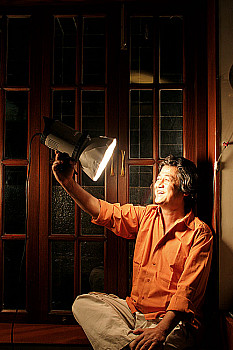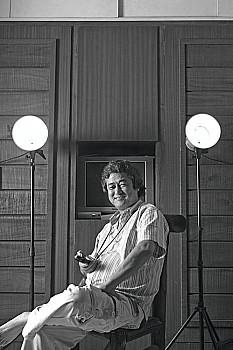Shooting The Screenplay
Binod Pradhan is a man of few words. On a mobile, you can’t get him to say more than a wary ‘Hello?’ especially if it’s a female voice at the other end. He puts it down to a fear of being pestered by ladies selling LIC policies and demat accounts! But even if you’re not soliciting business, you know he’d like you to state your business and be done with it.
There’s the stillness of a Buddhist lama about him – a calm he’s carried with him despite three decades in the hysterical hi-octave world of films. When you grow up with the majestic Kanchanjunga as the mainframe of your life, it adds a certain stillness to your being.
As a quiet little boy in Kalimpong, some of Pradhan’s best buddies were the perfect picture frames strewn around generously by Mother Nature. The texture of a bark, the exquisite veins on a maple leaf. The first blush of a rosebud. All set against rolling green vistas.
Each morning, instead of taking the school bus, Pradhan would walk the miles to St Joseph’s Convent, in the crisp morning air, with a cloud or two for company. And once he reached his destination, there was the mighty mountain peak, beckoning, right behind the school loo.
So when nature called, it really did!
With such an excess of nature’s bounty, what do you do, but befriend it. And like all good friends you want to take it home. So Pradhan’s dad who worked at a photo studio, bought him a box camera.
Who knew then what journeys the shy, little boy would make with his camera.
We’re sitting in his quaint home, tucked away at the end of a road in Khar. It’s a suburb lying etherised upon a table – waiting for the makeover surgeon’s scalpel. But Pradhan’s home has resisted the advances so far. It’s just the kind of house Raj Khosla shot his rain-soaked black and white thrillers…it’s old, with real vines growing out of Gothic ones.
You’re greeted at the door by his dogs – Maya and the Scottish, Malt. They’re beauties and they know it.
Pradhan is a little less self-assured. There’s a puzzled furrow on his brow: “Once again, why are you here?” And as you talk to him comes the startling realisation that, while the world’s been raving about his work for years, Binod Pradhan has been spectacularly out of the loop!
He’s unarguably one of the best cinematographers of our time. His frames stay with you long after you’ve walked away from a film. He uses his camera like a paintbrush. That sensuous, almost lyrical love-making scene between Madhuri Dixit and Anil Kapoor in Parinda, the breathtaking sweep of 1942… A Love Story, the luminescence of Aishwarya Rai’s close-ups in Devdas, and now, he’s excelled himself with Rang De Basanti. The cutting-edge camerawork transports you into the fevered and furious heart of the film.
“Yes, we’ve experimented a lot with Rang De…. Like we’ve used four frames per second for the title shots, we’ve used the tilted camera Dutch angle shots for dramatic effect; there’re a lot of day for night shots that we’ve enhanced with lab work…for the right effect,” says Pradhan, and he’s still not very pleased with the sepia tones of the flashbacks. “It’s not the tint I wanted.”
As a little boy in Kalimpong, he’d painstakingly transform ordinary black and white pictures into living colour with just an old brush and watercolours….
It’s come in handy today.
Initially, his dad would find him a pest as he’d potter around the studio, shoot portraits of unknown people and blow them up on expensive photo paper.
“It cost just 80 paise to make an 8×10 b/w print, but dad would blow a fuse anyway,” recalls Pradhan. The good part was that invariably, his pictures would find their way into dad’s display case. As a reward, his father presented him with an Asahi Pentax.
They were inseparables, after a few initial pangs. “I didn’t know that the aperture numbers worked backwards, so the first assignment with dad, no less than the school’s Annual Day, ended up a heart-stopping blur.”
But Pradhan didn’t make the same mistake twice and by the time he was 14, he was pretty much in charge of the brand new photo studio set up by his dad.
Remembers Pradhan, “A soldier came in to have his passport photos taken, and when he saw me behind the camera, he shot out of the chair. ‘Don’t you have a grown-up around to shoot the pictures?’ he asked. I told him I was chief photographer!”
Apart from the camera, the other friend Pradhan had was the gateman at the local Novelty theatre. He was such a regular that he got the best seats. “I remember the first film I ever saw was The Lone Ranger…. I was mesmerised. I never dreamed I would be a part of something so magical one day.”
He recalls the ‘Adult’ films –The Mummy and Frankenstein – he never got to see because, despite their long-standing friendship, the doorman wouldn’t look the other way.
“It was a pretty isolated life back at Kalimpong. I was very serious about a career in photography, but I had no one to teach me. Though I read all the books possible, I knew I needed a mentor. I remember reading that there was a chemical in an ox’s bladder that gave great gloss, so I went over to the butcher with a bottle and it really worked! But whom could I share my experiences with?
“Then someone mentioned the Film and Television Institute of India (FTII) in Pune…. It was a daunting thought. I didn’t even know where Pune was on India’s map; the only city I’d ever travelled to was Kolkata. But I made the journey and despite the greenhorn I was, the professors were impressed with my portfolio and I was admitted to the three year course in cinematography.
But Pune came as a big shock.
“Up at Kalimpong we were all pretty much cut from the same cloth. Here, people didn’t just look different, even their accents were difficult to catch. Besides down here anyone with Nepali features was a Gurkha and that meant you were either a chowkidar in a building, or you pretended to be Chinese and rustled up chow mein on a cart…’’
The prejudice was a real downer, initially, but the course was so absorbing that nothing else really mattered.
The break into Mumbai came pretty effortlessly too. Film director, Prem Sagar had come to the Institute to judge their work and he was so impressed with Pradhan’s work that he offered him a job as an assistant at Sagar Arts.
Mumbai was a bigger shock. Big budgets, big egos and bigger insecurities.
“I remember helping out with the lights one day, because the guy who did them was a little late…and he got very angry. He thought I was trying to poach on his turf.”
This was also where he met his first big star, Dharmendra. “He was a real warm person. I remember he came forward to shake hands, and what a huge hand it was!” laughs Pradhan.
Pradhan assisted Prem Sagar on the Dharam-Hema Malini starrers, Charas and Ram Bharose, but it was a huge set-up and he knew he’d be lost somewhere in there if he didn’t get out fast. That’s when ace-cameraman, A K Bir, who was making a little film called Gharonda (Amol Palekar-Zareena Wahab) took him into his fold as assistant cameraman in charge of the ‘zoom and focus’ department. “It’s a pretty crucial job. You could hand in the wrong lenses and mess up the day’s work,” he says. And it proved a very useful internship.
But he was adrift in this huge ocean and getting work was very difficult. “I don’t know how to ask for work. All the work I’ve ever got is when someone has come looking for me.”
That wasn’t easy either because for years Pradhan had no fixed address.
“I remember during one of my down and out phases, a friend of mine offered to take me to Brunei. I was earning about Rs 500 a month then and the job offered Rs 10,000. But I had a great sense of destiny. I knew this was where I was meant to be.”
He did documentaries for Durga Khote Productions. Ads, a couple of corporate films, honed up on his lighting skills…
“But I’d say, I was basically out of work,” he laughs, reaching for a glass of water. “You know, I’ve never talked this much before, my throat is dry!”
“I have no sense of chronology about my life,’’ he confesses. “Where was I?”
“Out of work,” I say.
“That was a permanent state,” he laughs.
There was one area in his life that was all blazingly lit up.
He lived as a PG with a Kutchi family and that’s where he met Dolly. She was like a cuddly toy you get with McDonald’s ‘Happy Meal’. They reduce the scale and the thing becomes so excruciatingly desirable that you’ve just got to take it home.
Dolly’s mum thought he was a Gurkha and so, no dice.
Pradhan got desperate. He married Dolly and they eloped to Kalimpong. She was all of 14 and Pradhan’s dad nearly suffered a convulsion on seeing the ‘happy couple’.
She was promptly enrolled at the local convent and the couple was told to shape up. Obviously they weren’t listening because a year later, little Bindy, their firstborn, arrived.
So now the Kutchi grandma called Kalimpong to say all was forgiven and the ‘Gurkha regiment’ could return home.
Since the work had almost completely dried up, Pradhan decided to devote himself completely to bringing up Bindy. “I bought Dr Spock and all the books on parenting I could lay my hands on. It was the most pleasurable experience of my life! I’d bathe him, massage him, feed him.”
Dolly, who’s sitting listening in, laughs, “He was so hyper that we’d get thrown out of shops because he’d bend and squeeze shoes to see if they were comfortable enough or he’d stretch the socks to see if the elastic would hurt.”
Slowly, old friends came looking for him; Jhanu Barua offered him an Assamese film, Apa Roopa (Beyond Beauty). He worked with Mani Kaul on the celluloid version of Ghashiram Kotwal and did Jabbar Patel’s Jait Re Jait.
Was he ever disheartened by the slow pace of his career?
“That’s something I’ve never felt. Whatever the work, I’ve done it with a sense of joy. For instance, I’ve never understood why people think of television as a comedown; whatever the frame, it’s up to you to make something of it,” he says passionately. Pradhan himself has done several serials like Kabir, Kab Tak Pukaroon, Dhundhle Saaye, and Manoranjan.
The dry spell finally broke when Kundan Shah got together all his mates from the FTII to make a film called Jaane Bhi Do Yaaron. Today, it’s become a cult film of sorts – but when it was released, it was dismissed as grossly over the top.
But Pradhan was among friends. It was a passionate lot – though there were huge budget constraints. “What I remember most about the film was the food we got,” he recalls. “In the morning it was daal chawal, doodhi; in the evening, it was doodhi, daal chawal….’’
Despite his formidable reputation, he hasn’t aligned himself with any influential ‘camp’. Friends like Vidhu Vinod Chopra repeat him (Khamosh, Parinda, 1942…A Love Story, Mission Kashmir) because of his exceptional talent and complete absence of attitude.
He’s worked with the biggest stars, raising the bar each time. He has also photographed some of the most beautiful women on the Indian screen. Madhuri Dixit in Parinda, Manisha Koirala in 1942…A Love Story, Aishwarya Rai in Devdas.
Who does he think is the most beautiful?
“They’re all very beautiful actresses and they all photograph effortlessly,” he says.
But which is the most perfect face through his lens?
“It would have to be Aishwarya,” he says, a trifle reluctantly….
Because in the end, it’s up to the artist to present his Muse.
And Pradhan has never let them down.
That’s why the good times have begun to roll in. “Finally, the money is good,” he laughs, and they’re about to move into their beautiful terrace flat in Lokhandwala “where I can re-establish my connection with infinity”.
What more could a man ask for?
Related posts from Verve:
Verve Trending
Sorry. No data so far.
us on Facebook to stay updated with the latest trends







